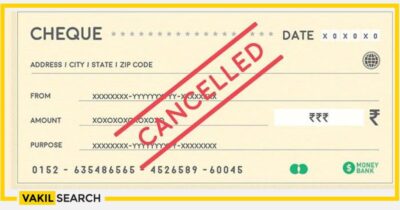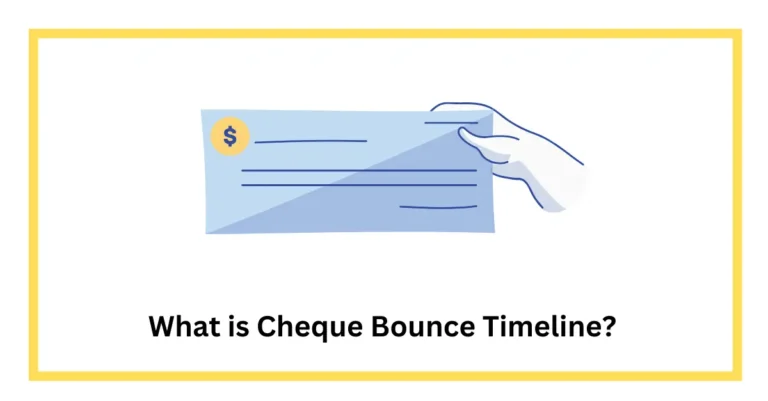Understand the importance of timing when dealing with cheque bounce cases. This synopsis provides key information on the stipulated time limit for filing a cheque bounce case, ensuring a comprehensive grasp of the legal landscape surrounding such incidents.
Time Limit for Filing Cheque Bounce Case: When there isn’t enough money in the account to satisfy the debt, a situation known as a cheque bounce occurs. The money needs to be retrieved right away. Before taking legal action, a letter requesting money is first given to the drawer. Sometimes a rapid settlement is made on the letter. Cheque bounce is a significant infraction that is punishable by both jail time and a fine according to the Negotiable Instruments Act. The drawer of the cheque must present the cheque within 30 days after the day it was dishonoured in order to protect his rights under the Negotiable Instruments Act. However, if you find yourself in trouble with the law due to a check bounce situation, you may contact a Vakilsearch legal expert to help you out. You can reach us at any time of day for more information about check bounce.
You should select us for the following reasons:
- There are no extra costs
- Your confidential information is safeguarded and kept secret
- You’ll have access to the best legal professionals working today.
A cheque is a “bill of exchange” that is cashable immediately. The person who writes the Cheque bounce is known as the “drawer,” while the person to whom it is written is known as the “drawee.” Cheques are used in almost all transactions, such as loan repayment, wage payments, payment of bills and fees, etc. The vast majority of checks are handled and passed through banks each day. The aim of issuing checks is to acquire proof of payment. However, a large number of people still view cheques as a secure method of payment.
How Do You Start Legal Action If a Cheque Bounces?
- Within 30 days of a dishonoured cheque, the cheque beneficiary sends the defaulter the Cheque Bounce Notice via registered mail. The notice of a bounced cheque must be written properly and include details about the transaction’s type, the amount involved, the date the cheque was deposited with the bank, the date the cheque bounced, the cause of the bounce, and the beneficiary’s request for payment within 15 days
- In the event that the cheque issuer defaults in payment, the payee may bring a criminal complaint in court within 30 days of the expiration of the 15-day notice period
- A court in the city where the cheque was presented must be contacted with complaints regarding cheque bounces.
- A hearing will be held after the case has been admitted in court, and court orders will be issued in accordance with Section 138 of the Negotiable Instruments Act
- Cheque defaulter would need to show up in court to get the issue resolved.
if the Payee places a check with the intention of withdrawing funds from his bank account, the address of the bank branch where he holds and manages the account. If the Payee deposits a check to receive the funds instead of using his bank account, the location of the Drawee bank branch is where the Drawer keeps and manages the account.
What Factors Must Be Taken Into Account For A Cheque Bounce Notice To Be Valid?
- The Negotiable Instruments Act’s Section 138 must be mentioned details about the cheque presentation
- Information on the request for immediate payment made to the cheque issuer and the cause of non-realisation of payment
- Within 30 days of the cheque being returned to the person who issued it, a notice must be delivered.
What Is The Cheque Bouncing Process?
- The demand notification is delivered within 30 days. The drawer has 15 days after receiving the demand notice to make payment
- The notice of a bounced cheque is issued by registered mail in order to establish delivery proof
- If payment is due within 15 days but is not, the payee has 30 days to file a complaint with the magistrate
- The state where the bank is located must receive a complaint.
Who May File A Case For A Bounced Cheque?
The Drawer is the one who files a cheque bounce case since the complaint or case of a dishonoured cheque is filed at the location where the cheque was presented for honouring. A case for the dishonour of a cheque may be brought not only against the specific person but also against any organisation that does so.
Any corporation or entrepreneur looking for a lawyer, chartered accountant, or company secretary can find all of these professionals at Vakilsearch. The legal cheque bounce case process in India is something we at Vakilsearch are continually working to improve. The ideal procedures and rules are known to us.
Penalties and Punishment
Once the complaint, an affidavit, and any relevant paper trail have been filed, the court will issue a summons and schedule a hearing. If found guilty, the defaulter could be subject to pecuniary penalties equal to twice the amount of the cheque, a jail sentence of up to two years, or even both. The bank also has the authority to suspend the account’s usage of a chequebook and shut it if there are numerous instances of bounced checks.
If the drawer settles the outstanding sum on the cheque within 15 days of receiving the notice, they have not breached any laws. If not, the payee has one month from the day of the 15-day window for responding to the notice to lodge a complaint in the jurisdictional magistrate’s court.
Given that a case for a bounced cheque is time-bound, the recipient of the cheque may also suffer from a lack of recourse if no action is taken against the defaulter by the receiver within the allotted period. As a result, it’s crucial to deal with a case of a bounced cheque as quickly as possible in order to avoid all the resulting repercussions.
New Cheque Bounce Rule
The new cheque bounce rule signifies an updated regulatory framework aimed at addressing instances where issued cheques are returned by banks due to insufficient funds or other specified reasons. This rule outlines the legal and procedural aspects associated with cheque bouncing incidents, encompassing circumstances such as insufficient funds, mismatched signatures, or premature presentation of post-dated cheques.
Understanding the nuances of this rule is crucial for both the issuer and the payee in navigating the legal implications of cheque bounce cases. Additionally, parties involved should be mindful of the stipulated time limits within which legal actions, such as filing a cheque bounce case, must be initiated to ensure a timely and fair resolution of the matter. Overall, the new rule aims to provide a comprehensive and streamlined framework for dealing with cheque bounce situations in financial transactions.
Circumstances of Cheque Bounce
Cheque bounce occurs when a cheque issued by an account holder cannot be processed by the bank. This can happen due to various reasons such as insufficient funds in the account, mismatched signatures, post-dated cheques being presented earlier, or other technical issues. Understanding the circumstances leading to a cheque bounce is crucial in determining the appropriate course of action and legal implications for both the issuer and the payee.
What is the Time Limit for Filing a Cheque Bounce Case?
The legal framework typically imposes a specific time limit within which a party can file a cheque bounce case after the occurrence of the bouncing incident. This time limit is essential for ensuring a timely and fair resolution of the matter. It is imperative for individuals and businesses involved in such cases to be aware of and adhere to the stipulated time frame for filing legal proceedings related to cheque bounce, as failure to do so may impact the validity of the case and subsequent legal actions.
In summary, the new cheque bounce rule introduces a framework to address and regulate instances of cheque bouncing, and understanding the circumstances and time limits associated with such cases is crucial for all parties involved in financial transactions.
FAQs related to Time Limit for Filing Cheque Bounce Case
1. What is the delay in sending legal notice in cheque bounce case?
If you could not send the legal notice after a cheque bounced within 30 days, don't worry . You can again present this cheque before the concerned bank and if bounces again, you can send the notice within 30 days.
2. Can I file a cheque bounce case after 4 years?
In accordance with the Negotiable Instruments Act, a legal notice must be dispatched within 30 days from the occurrence of a cheque bounce. Subsequently, the filing of a case must take place within a total of 45 days, comprising the initial 30 days for sending the legal notice and an additional 15 days. If the case is initiated beyond this specified timeframe, it will be deemed time-barred.
Conclusion: Time Limit for Filing Cheque Bounce Case
In India, the Negotiable Instruments Act’s Section 138 defines cheque bounce as a crime. Therefore, if a complaint is made in court, the defaulter may be sentenced to two years in prison and/or a fine that is up to twice the amount of the cheque, depending on the circumstances.
In some circumstances, the court may impose a fine for a cheque bounce case; often, this happens when the court deems the infringement to be severe. For all of your check bounce cases, go with Vakilsearch. Our experienced legal professionals will assist you throughout the procedure.
Read more:-
- Maximum Penalty for Cheque Bounce
- Notice Format for Bounced Cheque
- Is Bounce Cheque a Criminal Offense?









